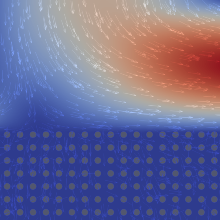Our SFB 1313 doctoral researcher Elissa Eggenweiler and principal investigator Iryna Rybak published the article "Interface Conditions for Arbitrary Flows in Coupled Porous-Medium and Free-Flow Systems" (pp. 345-353) in the Springer book "Finite Volumes for Complex Applications IX - Methods, Theoretical Aspects, Examples"*. The book is a part of the Springer Proceedings in Mathematics & Statistics book series (FVCA 9, Volume 323).
Abstract
Physically consistent interface conditions are important for accurate mathematical modelling and numerical simulation of flow and transport processes in coupled free-flow and porous-medium systems. Traditional coupling concepts are valid for simplified cases only, such as flows parallel to the fluid-porous interface or very specific boundary value problems. This severely limits the range of applications that can be accurately modelled. Evidently, there is a need for more general interface conditions to couple free flow to porous-medium flow.
In this paper, we propose new coupling conditions for arbitrary flow directions and periodic porous media. These conditions are derived by the theory of homogenization and boundary layers and are applicable to general filtration problems. The derived set of coupling conditions are validated by comparison of pore-scale to macroscale numerical simulations.
----------
* Klöfkorn, R., Keilegavlen, E., Radu, F. A., Fuhrmann, J. (2020). Finite Volumes for Complex Applications IX - Methods, Theoretical Aspects, Examples. FVCA 9, Volume 323, Springer Proceedings in Mathematics & Statistics, Bergen (Norway), 775 pages.


